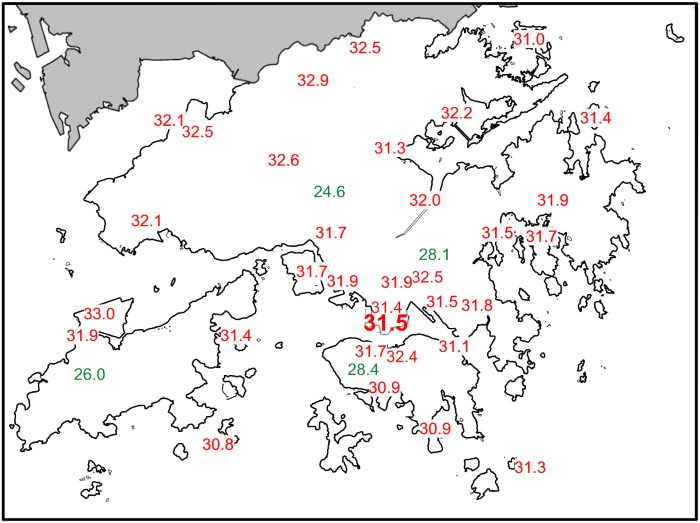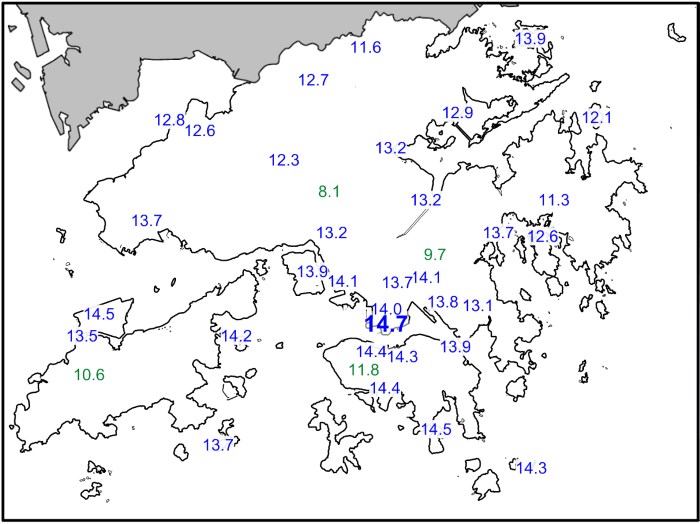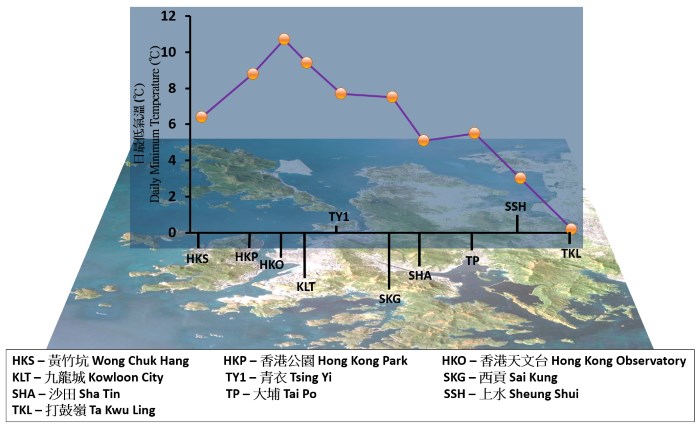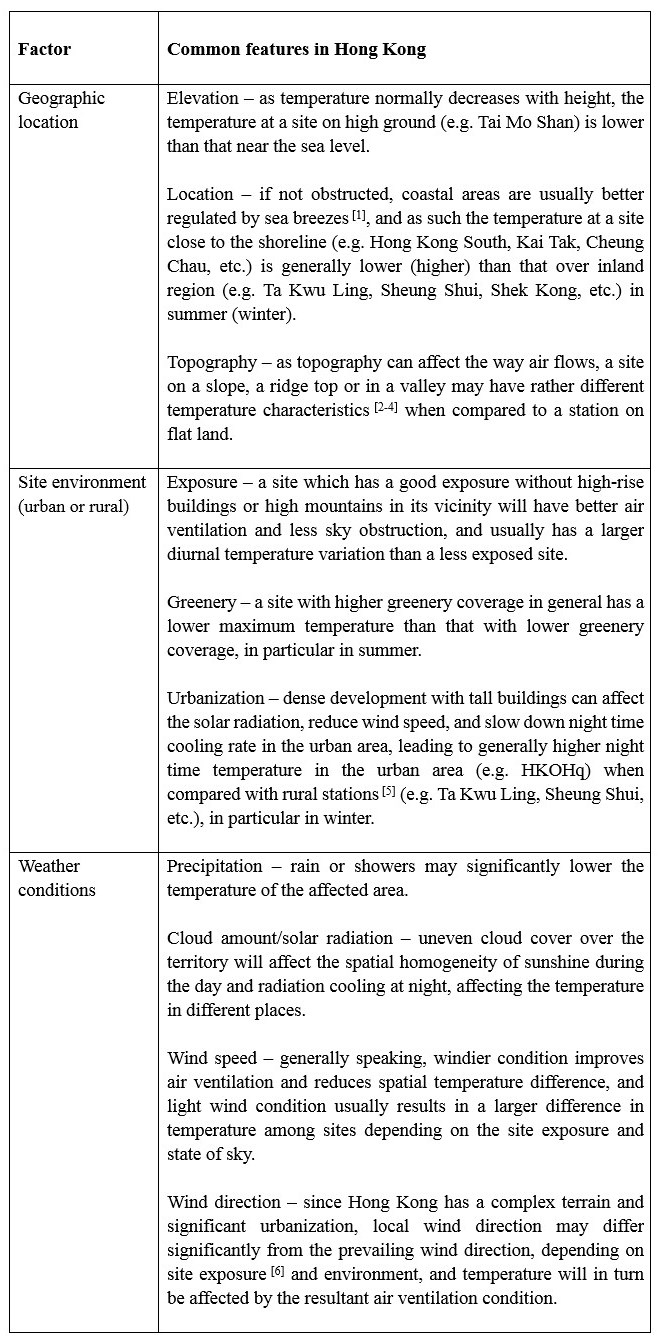Spatial temperature variations in Hong Kong
23 January 2017
Hong Kong is a densely populated coastal city with complex topography and large variations in the extent of urbanization. Weather data from various automatic weather stations of Hong Kong reveal that there are significant temperature variations over different parts of the territory. In some cases, there could also be noticeable temperature differences between stations within the same region (e.g. urban area) due to the influence of weather condition and surrounding environment.
Main causes of spatial temperature variations
Among the weather stations in Hong Kong, the Hong Kong Observatory Headquarters (HKOHq) at the heart of Tsimshatsui is one of the World Meteorological Organization stations in Asia with over a century of continuous observations of essential surface meteorological observations. With the advent of the automatic weather station network since 1980s, local climate statistics at enhanced temporal and spatial resolution have also been compiled over the past several decades. Figures 1(a) and 1(b) show respectively the spatial variations of average maximum temperature in summer (June - August) and average minimum temperature of different stations in winter (December - February) in the years 2010-2015. The observed spatial temperature variations can be attributed to three main factors, namely geographic location, site environment, and weather condition (see table in the Appendix). The combined effect of these factors will contribute to the day-to-day or seasonal changes in spatial temperature patterns over Hong Kong.

Figure 1(a)Spatial variation of the average maximum temperature at different stations in summer (June - August) for 2010-2015. Stations on high ground are in green.

Figure 1(b)Spatial variation of the average minimum temperature at different stations in winter (December - February) for 2010-2015. Stations on high ground are in green.
Some interesting cases for illustration
High temperatures on 24-27 June 2016
Under the dominance of the subtropical ridge, the weather was generally fine and very hot in Hong Kong with the maximum temperature at HKOHq topping 35oC on 24-27 June. Located roughly at the centre of the urban area in Kowloon with significant on-going urbanization effect, HKOHq experienced a long-term decreasing trend in wind speed. With very little wind to speak of and under prolonged sunshine during the day, HKOHq reported very high daytime temperatures over this period. Meanwhile, there were also isolated showers each day affecting the northern part of the New Territories and parts of Sai Kung and Hong Kong Island that suppressed daytime temperature rise elsewhere. As a result of site environment, geographic exposure and local weather conditions, the maximum temperatures at HKOHq ended up higher than many stations in the territory (the situation on 25 June as an example shown in Figure 2).

Figure 2Daily maximum temperature at different stations and daily rainfall distribution in Hong Kong on 25 June 2016. Stations on high ground are in green.
Clear and cold morning on 18 December 2010
Under the influence of a continental airstream over southern China, local weather was mainly fine on 17 December. Light wind condition and clear sky at night enhanced the radiation cooling effect in Ta Kwu Ling, bringing the temperature all the way down to a minimum of 0.2oC in the early morning on 18 December 2010. In the urban area, shielded by the urbanization effect, the night time cooling rate was much slower and the minimum temperature at HKOHq was 10.7oC, more than 10 degrees higher than that of Ta Kwu Ling (Figure 3).

Figure 3Schematic showing variation of daily minimum temperatures across the territory from urban to rural areas on 18 December 2010.
Consistency in temperature observation amid changes
Hong Kong is a high-density city with a constant need for new development. HKOHq and other weather stations, either in rural or urban areas, will unavoidably experience a varying degree of changes in their surrounding environment over time (e.g. land use, building development, vegetation coverage, etc.). The temperature at HKOHq has been serving as one of the key references for Hong Kong since 1884. The setting up of more weather stations over different parts of Hong Kong, including those within the urban area itself, has added more spatial information for reference in recent years. Analyses of the temperatures of HKOHq and other urban stations nearby suggest that the year-to-year and seasonal variations of these urban stations, as well as their overall trends, are generally in line with each other despite the observed spatial differences in geographic location and site environment. Long-term weather observations from these stations, in particular data at HKOHq that are more than a century long, document the climate variations in Hong Kong through time due to global climate change impact as well as local urbanization effect, thereby providing an invaluable source of climate information not only for Hong Kong but also for the world.
T.C. Lee, K.W. Li and Y.H. Lau
Appendix:

References:
[1] 秋風夜雨 (Chinese only)
https://www.youtube.com/watch?v=1tRJjlhJEDY
[2] Why is my home colder?
https://www.hko.gov.hk/en/Observatorys-Blog/101756/Why-is-my-home-colder
[3] The Higher the Place, the Stronger the Wind?
https://www.hko.gov.hk/en/education/weather/wind-and-pressure/00449-the-higher-the-place-the-stronger-the-wind.html
[4] What is gravity wind?
https://www.hko.gov.hk/en/education/weather/meteorology-basics/00008-what-is-gravity-wind.html
[5] Warm nights
https://www.hko.gov.hk/en/Observatorys-Blog/100674/Warm-nights
[6] Example: Exposure of Kai Tak Wind Station
https://www.hko.gov.hk/wxinfo/ts/sec_anemometer_e.htm
Main causes of spatial temperature variations
Among the weather stations in Hong Kong, the Hong Kong Observatory Headquarters (HKOHq) at the heart of Tsimshatsui is one of the World Meteorological Organization stations in Asia with over a century of continuous observations of essential surface meteorological observations. With the advent of the automatic weather station network since 1980s, local climate statistics at enhanced temporal and spatial resolution have also been compiled over the past several decades. Figures 1(a) and 1(b) show respectively the spatial variations of average maximum temperature in summer (June - August) and average minimum temperature of different stations in winter (December - February) in the years 2010-2015. The observed spatial temperature variations can be attributed to three main factors, namely geographic location, site environment, and weather condition (see table in the Appendix). The combined effect of these factors will contribute to the day-to-day or seasonal changes in spatial temperature patterns over Hong Kong.

Figure 1(a)Spatial variation of the average maximum temperature at different stations in summer (June - August) for 2010-2015. Stations on high ground are in green.

Figure 1(b)Spatial variation of the average minimum temperature at different stations in winter (December - February) for 2010-2015. Stations on high ground are in green.
Some interesting cases for illustration
High temperatures on 24-27 June 2016
Under the dominance of the subtropical ridge, the weather was generally fine and very hot in Hong Kong with the maximum temperature at HKOHq topping 35oC on 24-27 June. Located roughly at the centre of the urban area in Kowloon with significant on-going urbanization effect, HKOHq experienced a long-term decreasing trend in wind speed. With very little wind to speak of and under prolonged sunshine during the day, HKOHq reported very high daytime temperatures over this period. Meanwhile, there were also isolated showers each day affecting the northern part of the New Territories and parts of Sai Kung and Hong Kong Island that suppressed daytime temperature rise elsewhere. As a result of site environment, geographic exposure and local weather conditions, the maximum temperatures at HKOHq ended up higher than many stations in the territory (the situation on 25 June as an example shown in Figure 2).

Figure 2Daily maximum temperature at different stations and daily rainfall distribution in Hong Kong on 25 June 2016. Stations on high ground are in green.
Clear and cold morning on 18 December 2010
Under the influence of a continental airstream over southern China, local weather was mainly fine on 17 December. Light wind condition and clear sky at night enhanced the radiation cooling effect in Ta Kwu Ling, bringing the temperature all the way down to a minimum of 0.2oC in the early morning on 18 December 2010. In the urban area, shielded by the urbanization effect, the night time cooling rate was much slower and the minimum temperature at HKOHq was 10.7oC, more than 10 degrees higher than that of Ta Kwu Ling (Figure 3).

Figure 3Schematic showing variation of daily minimum temperatures across the territory from urban to rural areas on 18 December 2010.
Consistency in temperature observation amid changes
Hong Kong is a high-density city with a constant need for new development. HKOHq and other weather stations, either in rural or urban areas, will unavoidably experience a varying degree of changes in their surrounding environment over time (e.g. land use, building development, vegetation coverage, etc.). The temperature at HKOHq has been serving as one of the key references for Hong Kong since 1884. The setting up of more weather stations over different parts of Hong Kong, including those within the urban area itself, has added more spatial information for reference in recent years. Analyses of the temperatures of HKOHq and other urban stations nearby suggest that the year-to-year and seasonal variations of these urban stations, as well as their overall trends, are generally in line with each other despite the observed spatial differences in geographic location and site environment. Long-term weather observations from these stations, in particular data at HKOHq that are more than a century long, document the climate variations in Hong Kong through time due to global climate change impact as well as local urbanization effect, thereby providing an invaluable source of climate information not only for Hong Kong but also for the world.
T.C. Lee, K.W. Li and Y.H. Lau
Appendix:
Three main factors for the observed spatial temperature variations

References:
[1] 秋風夜雨 (Chinese only)
https://www.youtube.com/watch?v=1tRJjlhJEDY
[2] Why is my home colder?
https://www.hko.gov.hk/en/Observatorys-Blog/101756/Why-is-my-home-colder
[3] The Higher the Place, the Stronger the Wind?
https://www.hko.gov.hk/en/education/weather/wind-and-pressure/00449-the-higher-the-place-the-stronger-the-wind.html
[4] What is gravity wind?
https://www.hko.gov.hk/en/education/weather/meteorology-basics/00008-what-is-gravity-wind.html
[5] Warm nights
https://www.hko.gov.hk/en/Observatorys-Blog/100674/Warm-nights
[6] Example: Exposure of Kai Tak Wind Station
https://www.hko.gov.hk/wxinfo/ts/sec_anemometer_e.htm